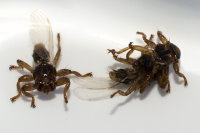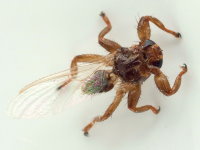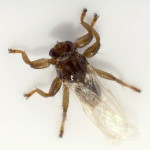Phylum Arthropoda (Arthropods) ➔ Subphylum Hexapoda (Hexapods) ➔ Class Insecta (Insects) ➔ Order Diptera (True flies) ➔ Family Hippoboscidae (Louse flies, keds)
Lipoptena fortisetosa Maa, 1965
Kleine Rehlausfliege
Synonyms and other combinations:
Lipoptena parvula Theodor, 1967 |
Classification:
Lipoptena fortisetosa belongs to the subfamily Lipopteninae.Distribution:
Originally native to the eastern Palaearctic, the species spreads westwards in Europe and was first recorded in Germany in 1992.Habitat:
Forests and their immediate surroundings.Description:
2,8 - 3,2 mm large, very flat, brown fly with 3 - 4 mm long wings.A similar species occurring in Germany is the Deer Ked Lipoptena cervi. This is significantly larger (5 - 6 mm) and begins its flight time later in the year. The two species can be distinguished by details of the bristles.
Biology:
Winged adults of Lipoptena fortisetosa appear from the end of May to the end of November (in Japan).Lipoptena fortisetosa is an ectoparasite of mammals. Well-known host animals are Manchurian and European elk, maral, red deer, fallow deer and roe deer.
Immediately after hatching, the adults of Lipoptena fortisetosa start to search for a suitable host. As soon as they find one, the very agile flies cling to the host's fur and throw off their wings. Males and females are bloodsuckers. They live and mate on the host. The viviparous females give birth to fully developed larvae, which pupate immediately after birth.
Note:
Similar to the big sister Lipoptena cervi Lipoptena fortisetosa flies to people, settles and can be very annoying.References, further reading, links:
- H. Schumann, B. Messner: Erstnachweis von Lipoptena fortisetosa Maa, 1965 in Deutschland (Dipt., Hippoboscidae), Entomologische Nachrichten und Berichte, 37,1993/4, 247-249



